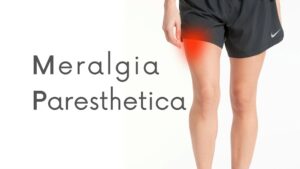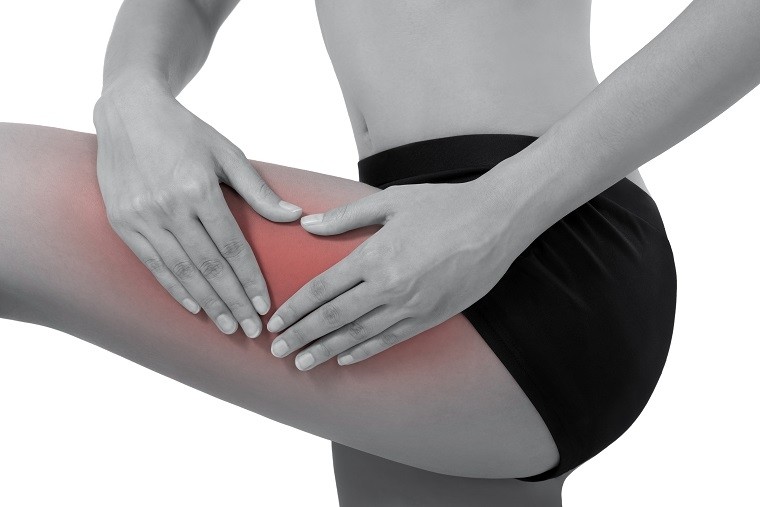Meralgia paresthetica is a condition that results in the sensation of burning, tingling, or numbness in the outer thigh. This condition can be caused by compression of the lateral femoral cutaneous nerve, which runs along the outside of the thigh. Physical therapy is often recommended for people who suffer from meralgia paresthetica. In this blog post, we will discuss how physical therapy helps to relieve symptoms of this condition.
Contents
What Is Meralgia Paresthetica?
 Meralgia paresthetica is a condition that causes numbness, tingling, and burning pain in your outer thigh. The pain is caused by compression of the nerve that runs from your hip to your thigh. This nerve is called the lateral femoral cutaneous nerve (LFCN). It is described as a “sharp, burning, or shooting pain” that is worse when you move your leg. It can also make it hard to wear pants because of the pain.
Meralgia paresthetica is a condition that causes numbness, tingling, and burning pain in your outer thigh. The pain is caused by compression of the nerve that runs from your hip to your thigh. This nerve is called the lateral femoral cutaneous nerve (LFCN). It is described as a “sharp, burning, or shooting pain” that is worse when you move your leg. It can also make it hard to wear pants because of the pain.
Meralgia paresthetica is more common in women than men and usually affects people between the ages of 30 and 50. It is also more common in people who are overweight or obese.
In fact, it is believed that up to 18% of obese people have meralgia paresthetica. The condition can be caused by anything that puts pressure on the LFCN. This includes tight clothing, such as belts, jeans, or suspenders. It can also be caused by pregnancy, hernia surgery, or any condition that results in abdominal swelling.
Therefore, if you have meralgia paresthetica, it is important to see a doctor to find out what is causing the pressure on your nerve.
Is Physical Therapy Good For Meralgia Paresthetica?
Many people with meralgia paresthetica find that physical therapy is very helpful in managing their symptoms. Physical therapy can help to stretch and strengthen the muscles around the affected area, which can help to relieve pressure on the nerve and improve circulation.
Meralgia paresthetica physical therapy can also help to improve the range of motion and flexibility, which can make it easier to manage symptoms on a day-to-day basis. Many people find that regular physical therapy sessions can help them to better control their symptoms and improve their quality of life.
There are various studies that support the use of physical therapy for meralgia paresthetica. A study published in 2010 found that physical therapy was an effective treatment for meralgia paresthetica in a way that both reduced symptoms and improved quality of life. Another study published in 2016 found that physical therapy can help to improve the range of motion and reduce pain in people with meralgia paresthetica.
If you are considering physical therapy for meralgia paresthetica, it is important to choose a therapist who is experienced in treating this condition. Physical therapy for meralgia paresthetica is typically performed by a physical therapist who has specialized training in treating nerve conditions.
Techniques Used In Meralgia Pareshetica Physical Therapy
 There are several types of techniques that can be used in physical therapy for meralgia paresthetica. Some of these techniques include:
There are several types of techniques that can be used in physical therapy for meralgia paresthetica. Some of these techniques include:
Manual lymphatic drainage
This is a type of massage that is used to help stimulate the lymphatic system and reduce inflammation. Manual lymphatic drainage can be very helpful in reducing pain and other symptoms associated with meralgia paresthetica. For example, this technique works to improve circulation and reduce swelling.
Therapeutic exercises
Exercises that are designed to stretch and strengthen the muscles and nerves in the affected area can be very helpful in treating meralgia paresthetica. Therapeutic exercises can help to reduce the pain and numbness associated with the condition, and can also help to improve the range of motion in the affected area.
Ultrasound
This technique uses sound waves to help reduce inflammation and improve blood flow. It’s also thought to help relieve pain by stimulating the release of endorphins, which are the body’s natural painkillers.
Interferential current therapy
This is a type of electrical stimulation that uses low-frequency currents. The goal is to help reduce pain and promote healing by interfering with the pain signals that are sent to the brain.
TENS
Transcutaneous electrical nerve stimulation (TENS) is another type of electrical stimulation that’s often used to treat meralgia paresthetica. During a TENS treatment, small electrodes are placed on the skin near the area of pain. A mild electrical current is then passed through the electrodes, which is thought to help block pain signals from reaching the brain.
So these are a few of the physical therapy treatments that may be recommended if you’re experiencing meralgia paresthetica. If you think this condition may be to blame for your pain, be sure to talk to your doctor or physical therapist to find out what treatment options are best for you.
Examples Of Meralgia Paresthetica Exercises
 If you have meralgia paresthetica, your doctor or physical therapist may recommend a variety of exercises to help relieve your symptoms. Here are some examples:
If you have meralgia paresthetica, your doctor or physical therapist may recommend a variety of exercises to help relieve your symptoms. Here are some examples:
Standing psoas muscle stretch
It is important to stretch the psoas muscle if you have meralgia paresthetica. The psoas muscle is located in the front of your hip and can become tight when you have this condition. To do a standing psoas muscle stretch:
- Stand with your feet about hip-width apart.
- Bend your right knee and place your right foot on a stool or chair in front of you.
- Lean forward slightly from your hips until you feel a stretch in the front of your left hip.
- Hold the stretch for 30 seconds, then repeat on the other side.
This type of exercise is important because it can help to stretch the psoas muscle and help to relieve your symptoms.
Pelvic tilt
Another exercise that can help you if you have meralgia paresthetica is a pelvic tilt. This exercise helps to strengthen the muscles in your lower back and pelvis, which can help to take some of the pressure off of the nerve that is causing your symptoms. To do a pelvic tilt:
- Lie on your back on the floor with your knees bent and your feet flat on the ground.
- Place your hand on your stomach just below your belly button.
- As you breathe in, tighten your stomach muscles and tilt your pelvis upward. You should feel your lower back flatten against the floor.
- Hold this position for a count of five, then relax as you breathe out.
- Repeat 10 times.
Hip extension
This is another exercise that can help with meralgia paresthetica pain. It works to stretch the muscles and tendons in the front of your hip. To do this exercise:
- Lie on your back on a flat surface with both legs extended in front of you.
- Bend one knee and bring it up toward your chest.
- Use your hands to grab hold of your thigh just below the knee.
- Keeping your back flat on the ground, slowly raise your leg until it is straight up in the air.
- Hold this position for 30 seconds.
- Repeat 3 times with each leg.
Clamshell stretch
It is one of the most effective exercises for meralgia paresthetica. The aim is to stretch and release the tension in the ilio-tibial band which runs along the outside of your thigh.
How to do it:
- Lie on your back on a flat surface with both legs extended in front of you.
- Bend your right knee and place your right foot flat on the floor.
- Keeping your left leg straight, use both hands to bring your right knee toward your chest.
- Hold for 30 seconds.
- Repeat 3 times with each leg.
Lunges
 Finally, this last physical therapy for meralgia paresthetica is a bit of an unconventional one, but some patients have found it helpful. Lunges are a great way to build up the muscles around your hips and thighs, which can be beneficial if you suffer from meralgia paresthetica.
Finally, this last physical therapy for meralgia paresthetica is a bit of an unconventional one, but some patients have found it helpful. Lunges are a great way to build up the muscles around your hips and thighs, which can be beneficial if you suffer from meralgia paresthetica.
To do a lunge, stand with your feet shoulder-width apart and take a large step forward with one leg.
- Bend your knees and lower your hips until both legs are at 90-degree angles.
- Make sure that your front knee is not extended past your toes and that your back knee does not touch the ground.
- Hold this position for a few seconds and then return to the starting position.
- Repeat with your other leg.
- Do 3 sets of 10 repetitions on each leg.
As you can see, there are a few different ways that physical therapy can be used to help treat meralgia paresthetica. If you suffer from this condition, talk to your doctor or physical therapist about which exercises and treatments might be best for you. With the right treatment, you can find relief from your symptoms and start living a normal, pain-free life.
Prevention Tips
Sometimes, there are things you can do to prevent or treat meralgia paresthetica. Some of the tips are listed below:
- Avoid tight clothing or belts: Clothing that is tight around the waist can put pressure on the nerves and cause meralgia paresthetica. Avoid wearing these types of clothing if you are susceptible to the condition.
- Maintain a healthy weight: Excess weight can also cause meralgia paresthetica. Losing weight may help to prevent or treat the condition.
- Stretch and strengthen the muscles: Stretching and strengthening the muscles around the hip can help to take pressure off of the nerves and prevent meralgia paresthetica.
- Use ice: Applying ice to the area can help to reduce inflammation and pain.
- Take over-the-counter medication: Pain relievers such as ibuprofen or acetaminophen can help to reduce pain and inflammation.
These preventive measures may not always work, but they are worth a try. If you are still experiencing symptoms, you may need to see a doctor for treatment. It is often believed that physical therapy can help to treat or prevent meralgia paresthetica.
Hence, if you are experiencing symptoms of meralgia paresthetica, consider giving physical therapy a try. It may help to relieve your symptoms and prevent the condition from recurring. With the help of a physical therapist, you can develop a stretching and strengthening program that is tailored to your needs. Contact a physical therapy clinic today to learn more.
Conclusion
To conclude, meralgia paresthetica physical therapy is considered to be an effective form of treatment. The main aim of physical therapy is to reduce the symptoms associated with this condition and to improve the quality of life for patients. As physical therapy can help to relieve pain, improve range of motion, and increase strength and endurance.
Therefore, if you feel that you may be suffering from meralgia paresthetica, it is important to consult with your GP or a physiotherapist. They will be able to devise a treatment plan that is tailored specifically for you and your needs.
Physical Therapy help patients recover from pain. If you’re experiencing Back pain, Shoulder pain, Knee pain, Neck pain, Elbow pain, Hip pain, or Arthritis pain, a physical therapist at MantraCare can help: Book a physiotherapy session.


